
U1 is a line on the Berlin U-Bahn, which is 8.8 kilometres (5.5 mi) long and has 13 stations. Its traditional line designation was BII. It runs east–west and its eastern terminus is Warschauer Straße S-Bahn station where it connects to the Schlesische Bahn. From there it runs through Kreuzberg via Gleisdreieck and Wittenbergplatz on to the Kurfürstendamm.

The U4 is a line of the Berlin U-Bahn in Germany that is the shortest in Berlin's U-Bahn system, with a length of 2.86 kilometres (1.78 mi). Opened in 1910, the U4 serves five stations, all of which are step-free: it is also the only subway line in Berlin to have never been extended and the only one to have no night service on weekends.

U5 is a line on the Berlin U-Bahn. It runs from Hauptbahnhof in Mitte eastwards through Alexanderplatz, Friedrichshain, Lichtenberg and Friedrichsfelde, surfaces in Biesdorf-Süd to pass Kaulsdorf and Hellersdorf above ground and finally reaches city limits at Hönow.
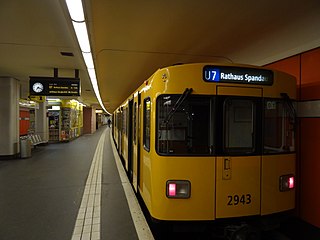
The U7 is a rail line on the Berlin U-Bahn. It runs completely underground for a length of 31.8 kilometres (19.8 mi) through 40 stations and connects Spandau, via Neukölln, to Gropiusstadt and Rudow. The U7 was originally the south-eastern branch of the Nord-Süd-Bahn (U6) that ran between the branching point at Belle-Alliance-Straße (Mehringdamm) and Grenzallee; however, in the 1960s, this stretch was separated from the rest of the line and extended at each end to form a new line.

U9 is a line on the Berlin U-Bahn. The line was opened on 28 August 1961 as Line G.
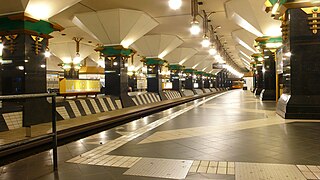
Rathaus Spandau is the western terminus of Berlin U-Bahn line U7. It was opened on 1 October 1984 with the line's extension from Rohrdamm to Rathaus Spandau. The station takes its name from the nearby Rathaus Spandau, the historic city hall of Spandau.
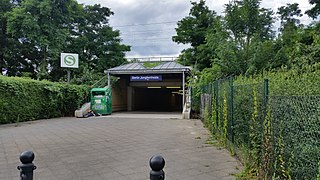
Berlin Jungfernheide is a railway station located at Charlottenburg-Nord, in the Charlottenburg-Wilmersdorf district of Berlin, served by the S-Bahn lines S41 and S42, the U-Bahn line U7 and Regional-Express trains of the Deutsche Bahn. Its name literally translates into "maidens' heathland"; it was named after the Jungfernheide, a former large forest in the proximity of this station.
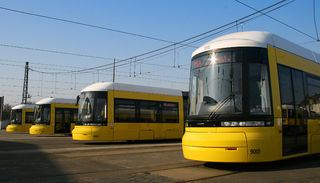
The Berlin tramway is the main tram system in Berlin, Germany. It is one of the oldest tram networks in the world having its origins in 1865 and is operated by Berliner Verkehrsbetriebe (BVG), which was founded in 1929. It is notable for being the third-largest tram system in the world, after Melbourne and St. Petersburg. Berlin's tram system is made up of 22 lines that operate across a standard gauge network, with almost 800 stops and measuring almost 190 kilometres (120 mi) in route length and 430 kilometres (270 mi) in line length. Nine of the lines, called Metrotram, operate 24 hours a day and are identified with the letter "M" before their number; the other thirteen lines are regular city tram lines and are identified by just a line number.

Breitenbachplatz is a Berlin U-Bahn station located in the Dahlem district on the U3.

Dahlem-Dorf is a Berlin U-Bahn station located on the U3. It serves the neighborhood of Dahlem and is one of two main stations used by students of the Freie Universität Berlin (FU Berlin), the other being Freie Universität (Thielplatz).
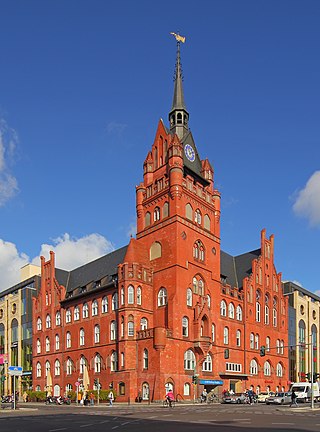
Steglitz is a locality of the Steglitz-Zehlendorf borough in Southwestern Berlin, the capital of Germany. Steglitz is a Slavic name for the European goldfinch, similar to the German Stieglitz.

Paradestraße is a Berlin U-Bahn station on the U6 line. It was opened in 1927 as Flughafen (airport) and at that time provided the world's first direct connection between a metro system and an airport.

Berlin Gesundbrunnen station is a railway station in Berlin, Germany. It is situated in the Gesundbrunnen district, part of the central Mitte borough, as an interconnection point between the northern Ringbahn and Nord-Süd Tunnel lines of the Berlin S-Bahn, as well as a regional and long distance station of the Deutsche Bahn network. The station is operated by the DB Station&Service subsidiary of Deutsche Bahn AG and is classified as a Category 1 station, one of 21 in Germany and four in Berlin, the others being Berlin Hauptbahnhof, Berlin Südkreuz and Berlin Ostbahnhof.

Berlin-Spandau station is a Deutsche Bahn station in the Berlin district of Spandau on the south-western edge of the old town of Spandau. The railway junction station is one of the 80 stations classified by Deutsche Bahn as a category 2 station. It has the longest train shed in Germany.
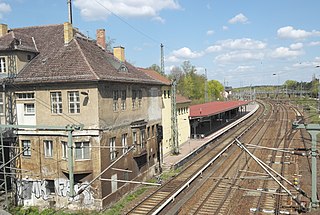
Birkenwerder is a railway station in the town of Birkenwerder, Brandenburg, Germany. The station lies of the Berlin Northern Railway and the train services are operated by Deutsche Bahn including Berlin S-Bahn services.

Bus transport is the oldest public transport service in Berlin, the capital city of Germany, having been introduced in 1846. Since 1929, services have been operated by the Berlin Transport Company, although during the Cold War-era division of the city they operated in West Berlin only. In East Berlin the public transport agency split off from the BVG and rebranded as BVB, operating the buses in the Soviet sector of Berlin.

The Rathaus Spandau is the town hall of the borough of Spandau in the western suburbs of Berlin, Germany. It was designed by Heinrich Reinhardt and Georg Süßenguth, and was built between 1910 and 1913. Until 1920, when Spandau was incorporated into Greater Berlin, it was the city hall of the independent city of Spandau.

The unbuilt U10 line, of the Berlin U-Bahn, was part of a planned "200-km-plan" extension of the Berlin U-Bahn from 1953–55. It would have been a large-profile (Großprofil) metro line running from Falkenberg, in the northeastern part of the city, to Alexanderplatz, and down to Steglitz before terminating at Drakestraße in Lichterfelde. The designated letter name of the line was "F" until 1 July 1972, when it was changed to "Line 10". Because a number of tunnels and stations were constructed to accommodate the proposed line with elements visible at transfer stations and elsewhere, the line is popularly known as the "Phantomlinie".

Line U2 is a line on the Vienna U-Bahn metro system. Opened in 1980, it currently has 20 stations and a total length of 16.7 km (10.4 mi), from Schottentor to Seestadt. It is connected to U1 at Praterstern and U4 at Schottenring.

The Berlin U-Bahn originated in 1880 with Werner Siemens' idea to build an urban railway in Berlin. During the nine years after the German Empire was founded, the city's population grew by over one-third and traffic problems increased. In 1896, Siemens & Halske began to construct the first stretch of overhead railway. On 1 April 1897, the company began construction of an electric underground railway. The Berliner Verkehrs Aktiengesellschaft (BVG) was formed in 1928, and took over further construction and operation of the network. In 1938, the company was renamed Berlin Transport Company; the original acronym, however, remained. Since 1994, the BVG has been a public company.






















